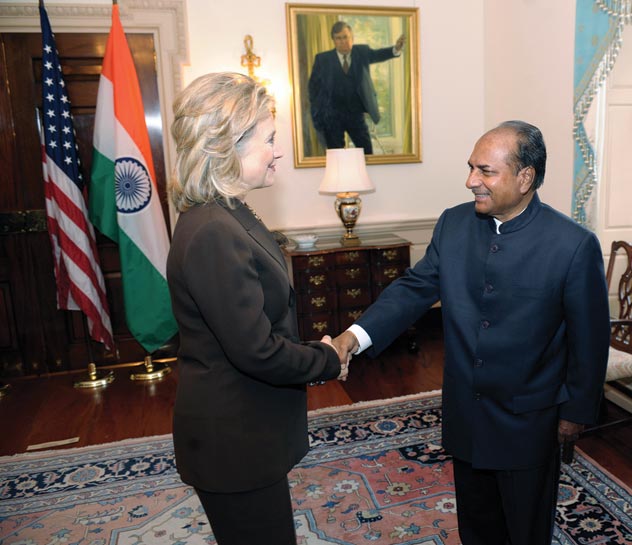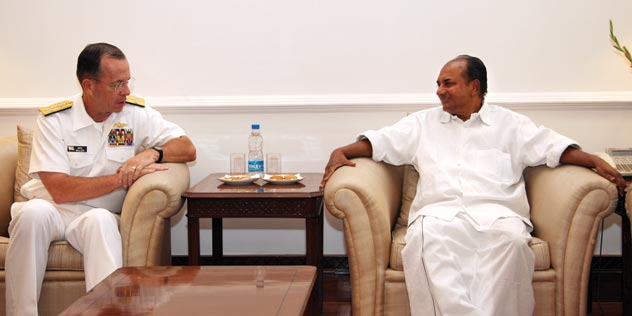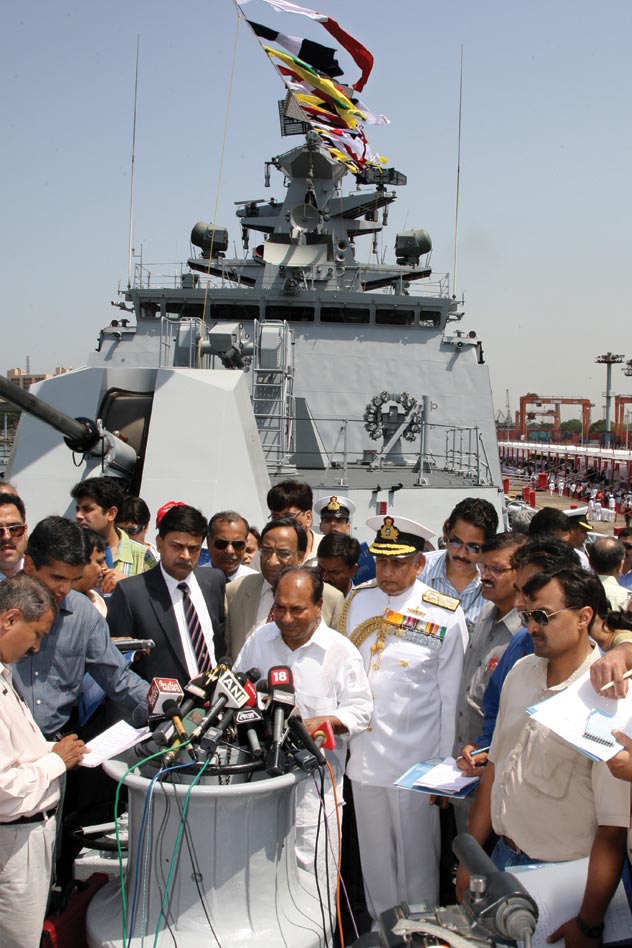SUBCONTINENT:
Embracing America: India's Defense Shift
U.S. President Barack Obama’s trip in November will boost Indo-American defense ties as India turns away from Russia and other former defense partners and eyes Israel and America for its arms needs, writes Siddharth Srivastava.

(Above): Indian Defense Minister A. K. Antony meeting U.S. Secretary of State Hillary Clinton during his visit to the U.S. in Washington Sept. 28. Antony visited America to iron out matters prior to the visit of U.S. President Barack Obama. [Photo: PRESS INFORMATION BUREAU]
India has made a definitive turn away from Russia and other long time partners France, Sweden and U.K. to Israel and America to procure arms.
Despite issues related to Washington’s anti-outsourcing stance, the visit of U.S. President Barack Obama in November will buttress Indo-American defense ties, aside from the deepening civil nuclear partnership.
Ties between India and America follow a strategic shift in the relations between the two countries over the last few years that resulted in the signing of the landmark civilian nuclear deal and defense agreements.
America has been promoting India as a counterweight to China in the region, apart from tapping new business opportunities.
America has emerged as India’s new military partner as New Delhi looks beyond Russia, India’s traditional military supplier dating back to the Cold War era. Problems with Russia include servicing and spare parts delays and obsolete technology.
The U.S., presently India’s sixth-biggest arms supplier, will likely be among the top three suppliers alongside Israel and Russia, in the next couple of years.
Indeed, this appears increasingly likely in the second stint in power of the Congress Party-led Manmohan Singh government as it has been unshackled from the tricky task of managing the earlier coalition for survival, especially placating the anti-American left parties.
With the exit of the left from the Indian ruling coalition, the role of Indian private firms in defense production has received a fillip, while American defense supplies and contracts are on the rise.

(Above): U.S. Chairman Joint Chiefs of Staff Admiral Mike Mullen calls on the Indian Defense Minister A. K. Antony in New Delhi July 23. Antony has said that India is keen to “diversify its defense procurement sourcing and wants America to ease export control restrictions” for full-fledged military exchanges. [Photo: PRESS INFORMATION BUREAU]
While much of the Congress-led government’s energies last term were utilized in tying up the Indo-U.S. civilian nuclear deal and dealing with recalcitrant communist allies that had problems with such growing strategic ties, security and defense are key focus areas this time around in the wake of traumatic events such as the Mumbai terror attacks in 2008.
In a buyer’s market India is looking to negotiate deals from a position of strength.
Keen to diversify its weapons procurement sourcing, India has told the U.S. to ease its export control restrictions to allow high-end weapons technology tie-ups between the two nations.
Defense Minister A.K. Antony, who visited America last month to iron out matters prior to the Obama visit, said that India is keen to “diversify its defense procurement sourcing and wants America to ease export control restrictions” for full-fledged military exchanges.
Antony held several rounds of meetings with U.S. Defense Secretary Robert Gates.
Over the last couple of years, the big arms deals inked with America include six C-130J Super Hercules aircraft for almost $1 billion (2007) and eight Boeing P-8I planes for over $2 billion (2009).
India has also acquired the airborne early warning aircraft, Hawkeye E-2D, developed by U.S. firm Northrop Grumman. There is a pending multi-billion-dollar deal for American C-17 cargo planes.
America has also been looking to sweeten defense deals with India to bag the $12 billion jet fighter deal.
Six global aerospace companies, Lockheed Martin, Boeing (American), Dassault’s Rafale (French), Gripen (Sweden), MiG (Russian) and Eurofighter Typhoon (a consortium of British, German, Italian and Spanish companies), are bidding for the MRCA or multi-role combat aircraft jackpot deal.
The MRCAs will replace the long-obsolescent, crash-prone MiG-21 interceptors and fit between the more powerful Sukhoi-30 and the low-end indigenous Tejas LCA lightweight fighters.
“The Pentagon is working with India to put three foundational agreements in place with New Delhi that would allow American frontline technologies to be shared with the country,” Washington recently said in an attempt to tilt the MRCA bids its way.

(Above): Indian Defense Minister A. K. Antony addressing the media after commissioning the INS Shivalik at Naval dockyard in Mumbai April 29. [Photo: PRESS INFORMATION BUREAU]
Indeed, events such as the Kargil incursion in 1999 during which the country nearly went to war with Pakistan and the November 2008 Mumbai terror attacks have only heightened India’s quest to stockpile arms, mostly acquired from abroad, as the domestic industry remains incipient.
In the decade that has followed Kargil India’s arms purchase deal value has crossed $50 billion, with every sign of such momentum being carried over the next decade and crossing $100 billion.
Pakistan remains the immediate focus of India’s military upgrade as evidenced by the recent successes in test firing of nuclear capable short range Prithvi missiles in quick succession for the first time.
The Prithvi missiles are aimed at hitting targets in Pakistan.
India’s arms acquisitions have more than doubled over the last five years from 2004-2009 ($35 billion) compared to 1999-2004 ($15.5 billion), as defense plans of the earlier period due to the Kargil conflict have been followed to fruition.
The defense ministry has inked over 450 arms contracts worth over $30 billion within the last three years.
Further, in response to perceived threats following the Mumbai attacks, India’s defense budget (2009-10) was raised by 34 percent to $30 billion, while officials say that defense modernization expenditure should easily scale over $100 billion between the years 2000-2020.
Over $10 billion was set aside by the government for net capital expenditure for last fiscal (2009-10), clearly indicating the impact of the Mumbai attacks.
The Stockholm International Peace Research Institute, a arms trade monitor, in its report for 2009, has said that India is the world’s second-largest arms buyer over the five-year period from 2005-2009, importing 7 percent of the world’s arms exports.
The top spot went to China. India could well take the number one spot as China is turning self sufficient in arms, while the former’s procurements continue to rise.
Even as America emerges as the new defense partners, others continue to sustain their high defense presence.
Deals with Israel include 3 Phalcon AWACS for over $1 billion (2004) and a $2.5 billion project to jointly develop medium-range surface-to-air missile systems (2009). India and Israel have finalized deals for the Barak-8 Naval air-defense system, and the Spyder surface-air-missile system.
France has been involved in supplying and building 6 Scorpene submarines, a $4.5 billion project (2005)
Russia’s stakes in India’s defense continues to be high with the $1.5 billion Admiral Gorshkov and MiG fighter package deal (now nearly doubled due to increased costs of the aircraft carrier’s refit) and 230 Sukhoi-30MKI fighter jets for $8.5 billion and T-90 tanks.
Britain has been involved in the 66 Hawk Advanced Jet Trainer (AJT) $2 billion project (2004).
|